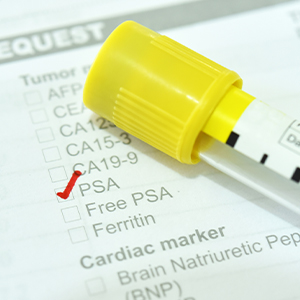Could It Be Prostate Cancer?

Let’s talk about prostate cancer.
Prostate cancer is the second-most common cancer diagnosed in U.S. men. One in eight men will be diagnosed with prostate cancer during his lifetime. (Source: American Cancer Society).
How does prostate cancer form? Who is most at risk? Can you make lifestyle changes to prevent it? Learn more about this common male cancer below.
What is prostate cancer?
The prostate is a gland in men about the size and shape of a walnut. It’s located behind the base of the penis and wraps around the upper part of the urethra. The urethra is the tube that carries urine from the bladder through the penis and out of the body.
As a man ages, his prostate cells may form tumors (lumps of cancerous tissue) or other growths. When abnormal prostate cells grow out of control and start to invade other tissues, they become cancerous.
Over time, prostate cancer may grow into bones and organs or spread to other parts of the body, making it harder to treat.
Prostate Cancer Symptoms
Prostate cancer may not cause symptoms at first, which is why screening tests are so important.
“Screening is the best way to find prostate cancer at an earlier, more treatable stage,” says Dr. Jessica Arden, MD, PhD, radiation oncology specialist for Munson Medical Center and Traverse Bay Radiation Oncologists. “A man whose prostate cancer is discovered through screening might have no symptoms at the time his disease is found.”
In advanced stages, prostate cancer symptoms may include:
- Problems urinating
- Less force in the stream of urine
- Blood in the urine and/or semen
- Bone pain
- Unexplained weight loss
- Erectile dysfunction
But the good news is, prostate cancer can be treated when found early.
“When identified at an early stage, prostate cancer is treatable. There are multiple treatment options that allow our patients and physicians to work together and identify which option is the best fit,” says Arden.
How is prostate cancer diagnosed?
Your family doctor or primary care provider must first examine you and run some tests to determine if you have prostate cancer and at what stage.
These tests may include:

Prostate-specific antigen (PSA) testing
PSA is a chemical made by prostate cells. The amount of PSA in the blood (PSA level) can be tested to check for prostate cancer. In general, a high or rising PSA level may mean there's cancer. But a PSA test by itself can't show if a man has prostate cancer.
Core needle biopsy
This test is needed to know for sure if a man has prostate cancer. During the test, a small probe is put into the rectum. The probe sends an image of the prostate to a video screen. With this image as a guide, your healthcare provider uses a thin, hollow needle to remove tissue samples from all over the prostate. These samples are sent to a lab and tested for cancer cells.
Not every abnormal prostate growth is cancer
These growths may also be non-cancerous benign prostatic hyperplasia (BPH) or abnormal PIN cells. BPH is not cancer and does not lead to cancer. PIN cells are not cancer cells, but if the pattern of cells is very abnormal, there’s a 1 in 5 chance that there may be cancer in another part of the prostate.
Risk factors for prostate cancer
Risk factors for prostate cancer include:
- Gender. Only men are at risk.
- Age. Men ages 50 and older are at higher risk. Most prostate cancers are found in men older than age 65.
- Race. Prostate cancer is more common in African-American and Caribbean men of African ancestry than men of any other race. And it tends to happen when these men are younger. It’s less common in Asian-American and Hispanic men than in non-Hispanic white men.
- Family history. Having a father or brother with prostate cancer greatly raises a man’s risk for the disease. The risk is even higher if more than one family member is diagnosed, especially before the age of 55.
- Chemical exposures. The U.S. Department of Veterans Affairs says that men who were exposed to Agent Orange during the Vietnam War are at higher risk for prostate cancer.
- Genes. Men with certain inherited gene changes are at higher risk for prostate cancer. But only a small amount of prostate cancers are strongly linked to gene changes.
Is prostate cancer preventable?
There’s no sure way to prevent prostate cancer.
Some risk factors like age, race, and family history are out of your control. But a healthy lifestyle may help to lower your risk for prostate cancer. Take these steps:
Get screened

Men between the ages of 55-69 should talk to their provider about personal risk factors and the need for screening.
Eat a balanced diet
Make sure to include fruits, vegetables, and lean protein prominently in your meals and limit high-fat meats and dairy foods.
Limit calcium in your diet
Too much calcium may raise your risk for prostate cancer. Normal amounts of calcium in dairy foods and drinks are fine, but talk with your healthcare provider before taking calcium supplements.
Maintain a healthy weight
Obesity is linked to a higher risk of a deadlier type of prostate cancer.
Stay physically active
Exercise at least 30 minutes on most days.
Schedule your screening
Talk with your primary care provider to see if your age or family history qualifies you for a prostate cancer screening.
If you don’t have a primary care provider, contact Munson Healthcare Find-A-Doctor by visiting Find-A-Doctor or by calling Ask-A-Nurse at 231-935-0951. We can help you find a provider nearby.
Munson Healthcare provides the latest coordinated care and treatments for men with prostate cancer, including SpaceOAR® and SpaceOAR VUE radiation therapy. Please contact us at 231-392-8400 or CancerServices@mhc.net for additional information.